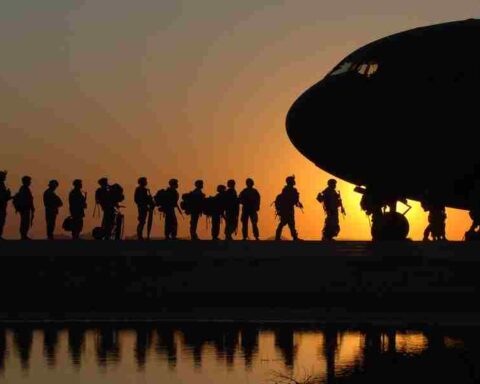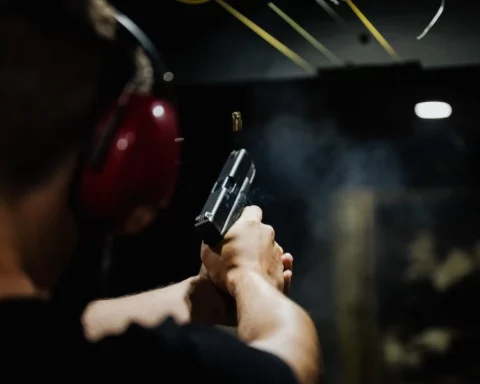Search
About Us
Follow
Signup to Newsletter
Get our regular posts notification, just subscribe our newsletter and keep reading.

Who Would Win A War Between US And Russia? The Ultimate Face Off

The intervention of the US in the war between Ukraine and Russia has left many wondering who would win a war between US and Russia. The chances of any country winning a war highly depend on its military structure.
Since World War II, countries worldwide have resolved to advance their weapon technology and build their military better than ever before.
This resolution led to the development of nuclear weapons capable of damaging entire cities and wiping out their entire population.
The US and Russia are one of the countries recognized for their deadly nuclear power. But who would win a war between the two? Let’s find out.
So, Who Would Win A War Between US And Russia?
The US has a higher chance of winning the war (without the involvement of Nuclear Weapons). The United States military has more advanced weaponry compared to Russia. They also have a more organized military with a highly advanced air force.
Nonetheless, the US government spends more on the military, with an estimated budget of $682 billion compared to Russia’s $93.76 billion.
Military Comparison Between The US And Russia
The Military power between the US and Russia varies in many ways, with US outshining Russia in certain areas and vice versa. Here’s a full comparison between the US and Russian military:
1. Air Force (Combat Aircrafts)
The air force deals with aerial attacks and both Russia and the United States have combat aircrafts.
However, the United States has more combat aircraft than Russia. Russia has an estimated 1,900, while the US has 3,318 combat aircraft. These stats indicate that the US has 75% more combat aircraft than Russia.
Additionally, the combat aircraft of the US is way more advanced in stealth technology and night vision. Therefore, they can easily pass through their enemy’s territory unseen. Nevertheless, they can easily attack their enemies from a greater distance.
2. Army (Attack Helicopters/Main Battle Tanks)
Attack helicopters and battle tanks are a significant part of the composition of a strong army. The United States is estimated to have 6,417 attack helicopters, while Russia has 1,655. Therefore, the US has 4% more attack helicopters than Russia.
In terms of main battle tanks, Russia has led with 22,710 battle tanks while the US only has 8,725.
Therefore has three times more main battle tanks than the United States. Though the US has fewer battle tanks, they are more advanced than Russia.
For example, the US M1 Abrams main battle tanks can launch attacks on enemies miles away. This ability give it an advantage over Russia’s tanks, which must be near its enemies to attack effectively.
However, Russia has 11% more armed forces personnel than the United States.
3. Military Budget
The United States spends more on military affairs than Russia, with more resources going to military research facilities.
Military research facilities are responsible for the advancement of military weapon technology and the creation of new weapons.
The fact that the United States spend 7% more on its military than Russia indicates that they take their military issues seriously.
4. Navy (Corvette Warships/Nuclear Submarines/Submarines/Aircraft Carriers)
The Navy deals with marine attacks that are both on top and underwater. Russia leads in the number of corvette ships having 68 more than the United States. It also has 15 more submarines than the United States.
However, when it comes to nuclear submarines, the United States takes the lead with 71 of them, while Russia only has 33. Additionally, the United States has more aircraft carriers, frigates, cruisers, and destroyers than Russia.
5. Military Organization
The United States military organization and that of Russia differ in a significant way. The US military has five branches. Namely, US Navy, US Army, US Air Force, US Coast Guards, and Marine Corps.
On the other hand, Russia’s military organization includes the three branches of the armed forces, two separate troop branches, special operation forces, and logical support.
The three branches of the armed forces include ground forces, Aerospace Forces, and the Navy. The two separate troop branches include strategic rocket forces and airborne forces.
6. Nuclear Weapons
Russia has 10% more nuclear warheads than the United States. However, both countries have enough nuclear power to tear each other apart and claim the lives of almost their entire populations.
What Would Happen If US And Russia Used Nuclear Weapons In Their War?
Many scientists have researched nuclear weapons and their dangers to human civilization. One catastrophic example of what a nuclear bomb can do is in the pictures taken after the explosion of atomic bombs over Hiroshima and Nagasaki.
The incident made Albert Einstein say in sorrow that the time has come when a man must give up war as a way of solving international problems. Here is what you should expect if the United States and Russia used nuclear weapons in their war:
Instant Loss Of Many Lives
Using nuclear weapons in the war between the United States and Russia would lead to the death of their citizens.
Not only will the people of the US and Russia die from the explosion, but also people who live in the neighboring countries.
The chances of anyone surviving a nuclear attack are zero. Nonetheless, animals and wildlife, including endangered species, will die from the nuke.
Radiation Poisoning
Nuclear weapons above the ground can send radiation up to 50 miles in the air. Therefore, those who reside within the areas around Russia and US are likely to develop symptoms of radiation poisoning.
Nuclear radiation could lead to death or even alter a person’s genetic code. Thereby, one exposed to the radiation might not be able to have children or might give birth to mutated offspring.
Eye Damage
Looking directly at a nuclear explosion could lead to damage to the eyes. Residents near the United States or Russia might experience eye problems ranging from temporary blindness to severe burns on the retina.
Property Damage
A single nuclear weapon can completely disintegrate a large city and wipe out the existence of everyone in it or around it.
Property that US and Russian citizens spent years building could all go away due to the involvement of nuclear weapons in the war.
Additionally, important information stored in museums and all the valuable research meant to improve human lives will also perish. Everything that people within the United States and Russia find important will all be obliterated.
Obliteration Of Global Food Systems
Most global food systems depend on giant economies such as the United States and Russia to run smoothly.
The two countries nuking each other means destroying the global food systems, leaving many hungry.
An estimated 5 billion people will die of hunger from the resulting destruction that will come from nuclear weapons.
The earth has approximately 7 billion people, and when 5 billion die, human civilization will be in danger.
Additionally, crop yield would decline by up to 7%. Though it might not look significant, it would exceed the largest anomaly the Food and Agriculture Organization has ever recorded since its beginning in 1961.
Multi-Year Nuclear Winter
According to research published in the Journal of Geophysical Research, a blanket of soot will block the sun’s rays from entering the earth two weeks after the nuke. The earth’s temperature would decrease by an average of 16 degrees Fahrenheit.
The drop in temperature would foster pole-like conditions in the areas covering Russia and the US. Surface light might take up to three years to return as the soot clears.
Destruction Of The Ozone Layer
The explosion of nuclear weapons in the US and Russia would destroy the ozone layer by heating the stratosphere.
Destruction of the ozone layer means more ultraviolet radiation will penetrate the earth’s atmosphere.
When the rate of ultraviolet radiation increases, humans and other animals will likely die from its burns.
Additionally, UV radiation will make the day unbearable to living things. The ozone layer blocks harmful UV rays from getting into the earth.
Plants will die from its harmful warming effect, and food scarcity will also lead to the death of humans.
How Do Nuclear Bombs Work
A nuclear bomb enhances energy released when subatomic particles separate or combine. The two ways of releasing nuclear energy from an atom include:
1. Nuclear Fission
Nuclear fission is when a nucleus splits into smaller sub-atomic particles such as gamma particles or neutrons. The process always produces a lot of energy that scientists need to make nuclear bombs.
2. Nuclear Fusion
Nuclear fusion is when two or more subatomic particles combine to form a larger nucleus. Nuclear fusion resembles the sun’s energy-generating process.
Fusing atoms takes a significant amount of energy that could damage the equipment. Therefore, current nuclear bombs only use nuclear fission to generate energy.
Conclusion
Military organization and the advancement of weaponry are excellent points of consideration when figuring out who would win a war between US and Russia.
The United States’ use of modern and technologically advanced weapons gives it an upper hand in winning the war.
Both countries have a good chance of holding each other, but the results would be catastrophic if they decide to employ nuclear weapons. Nuclear weapons pose a danger to the human race, and it would be best to destroy them before they destroy us.
Share Article
Susan Tapia is an ambitious, savvy news writer with a vibrant personality and an eye for detail. She is highly experienced in crafting compelling stories and dedicated to seeking out the truth. With her inquisitive nature, she delves deep into every subject she touches, uncovering unexpected facts that help her engage her readers. Susan has an unbridled passion for writing, and she strives to inspire others through her work. She confidently shares her thought-provoking ideas with enthusiasm and candor, making sure the world can see the truth no matter how uncomfortable it may be. Simply put, Susan Tapia is a trailblazer in the journalism industry who never fails to deliver her readers riveting stories they won't soon forget.

























